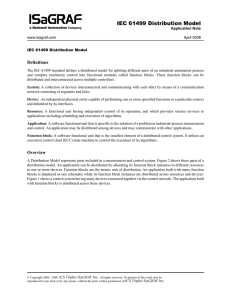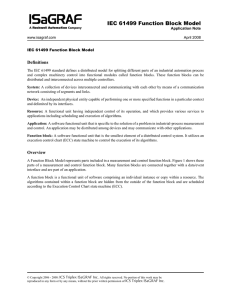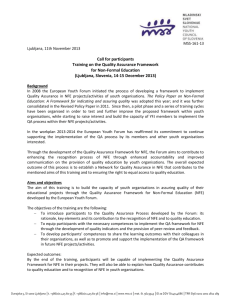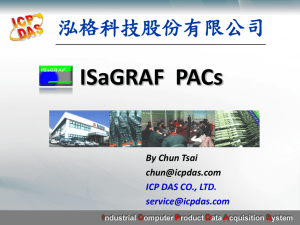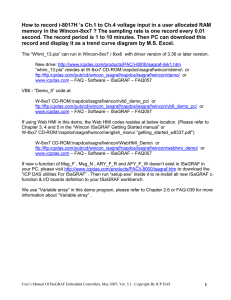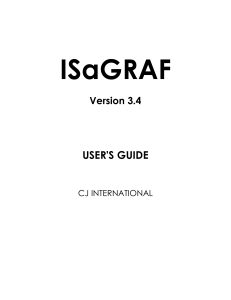Front-end of a telecontrol system
advertisement
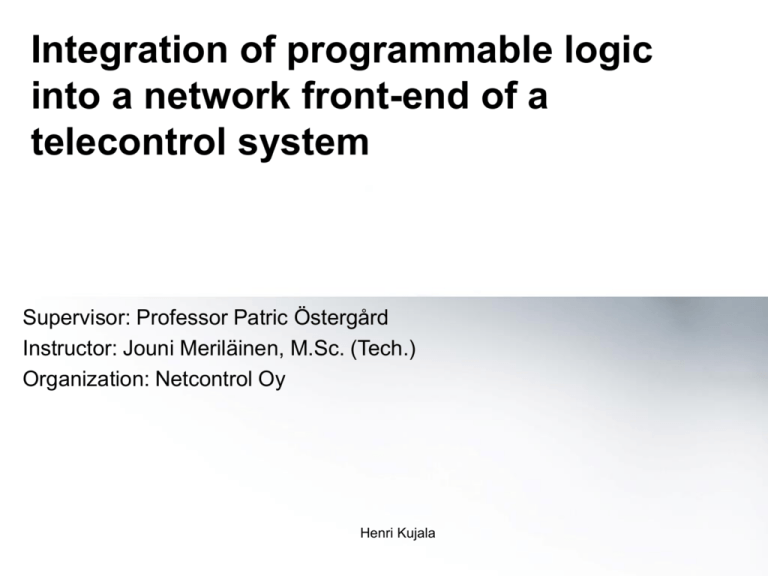
Integration of programmable logic into a network front-end of a telecontrol system Supervisor: Professor Patric Östergård Instructor: Jouni Meriläinen, M.Sc. (Tech.) Organization: Netcontrol Oy Henri Kujala Contents • Objective of the thesis • The field of electricity distribution – Related subjects: network front-end, programmable logic • Implementation – I/O devices and data types • Configuration constructed for verifying results • Fault clearing application for testing purposes • Summary Objective of the thesis • The purpose of integration of programmable logic into a network front-end of a telecontrol system is to offer a programmable logic platform – Aid in the automatization of the environment of remotely controlled stations, namely substations • Automatization for economical reasons and also to improve the usability of the network by increasing the level of reliability • The aim is to make the programmable logic environment co-operate with the front-end device Field of electricity distribution • The field is geographically distributed – Unmanned remote stations • Telecontrol is defined as the remote transmission of operating information • Telecontrol applied in electricity distribution networks – Control and command of relays, breakers and switches • A master/slave model, where the control centre is the master and the slave stations are called substations • The key parameters of an electricity distribution network are voltages and currents Front-end of a telecontrol system NFE • A device resembling computers – CPU, memory, ports for communications, database for storage • Located at node points in the network • Front-end devices pre-process information exchanged between substations and the control centre • Used as protocol converters and data concentrators • An example of a front-end device is the NFE (Network Front-End) from Netcontrol – NFE504 is the specific NFE unit used throughout this thesis Programmable logic – PLC and softPLC • Programmable logic is used in the control of traffic lights, for example • Programmable logic controller – PLC – PLCs execute tasks in a loop, called the scan cycle • softPLC – software-based control – softPLC means that the functions of a PLC are executed on a PC platform in software • The selected softPLC application is ISaGRAF from ICS Triplex and it is used throughout this thesis as the softPLC environment – Other platforms also available ISaGRAF environment • Hardware independent – portable • Consists of a workbench and a target • Workbench for programming the applications and target for executing these • Target: one virtual machine for one resource • Different target models: multi- and monotasking; medium (16-bit) and large (32-bit) • Project database is a Microsoft Access database ISaGRAF input and output devices • There are two types of I/O-devices – Simple devices – Complex devices • Simple devices are one-way (input or output) • Complex devices are combinations of simple devices • An I/O-driver consists of a multiple of ISaGRAF devices Implementation • ISaGRAF communicates with the NFE using NFElink protocol • Also an interface module called NFElinkITF is used in the communications process – NFElinkITF is an interface, which facilitates communications between ISaGRAF and NFElink • I/O interface for the connection between ISaGRAF and NFE was constructed Implementation (2) • The structure of NFE data types is taken into account when constructing ISaGRAF I/O-devices – A dedicated ISaGRAF I/O device and data type for each NFE data type was created • The correspondence of the data types is almost one-to-one • The I/O interface constructed uses the created ISaGRAF data types to access the corresponding data types at the NFE NFE data type ISaGRAF data type NPCBIN ISABIND NPCBIND ISABIND NPCINT ISAINT NPCFLOAT ISAFLOAT NPCCMD ISACMD NPCSTRING ISASTRING NPCLINE ISALINE NPCREG ISAINT NPCLOG ISALOG NPCTIME ISATIME Cross-reference • Due to differences in addressing notation, crossreferencing is needed • ISaGRAF notation is of type %(I/Q)AX.Y.Z – I/Q stands for input/output, respectively – A is the type of channel • U for user generated and D for integer, for example – X.Y.Z is the channel number consisting of ISaGRAF device index (X), the index of the simple device inside the complex device (Y) and the channel number (Z) • NFE database addressing is as follows: – Group structure of 16 bits identifies the NFE channel and data type – A hexadecimal 32-bit index identifies the I/O point inside the group Cross-reference (2) • One ISaGRAF channel is mapped into a combination of one NFE channel, one data type and one index in the group of data types • Example: – NFE channel 2, data type NPCCMD and index 0x02000003 (hex notation) is mapped into ISaGRAF data type ISACMD, channel 2, which here, in correct notation format is %QU0.2.2 Advantages of the implemented model • Advantages: – Easy to expand and improve – Benefits from NFElink – Redundancy of NFE’s handled by NFElink • Disadvantages: – One additional layer between the NFElink and ISaGRAF caused by the NFElinkITF Configuration • A real-life environment • Process simulator based on Mitsubishi’s PLCs • Netcontrol’s Netcon 500 substation – NFE504 as the front-end device – IO64 cards for input/output • ISaGRAF softPLC environment • iFix industrial automation software for controlling and visualizing the demo configuration • NFElink + NFElinkITF for accessing the NFE database • PC computer for programming and executing the ISaGRAF logic Configuration (2) Application example • The application is an automatic fault clearing application • The fault clearing process is automatic, but the starting of the application has to be triggered (currently manually) • When clearing is finished, the trigger is reset • The automation of the starting of the fault clearing process is possible to accomplish with little effort Fault clearing • The exchange of triggering information benefits from CMT (Connection Manager Test) module • The triggering information itself is virtual • Fault clearing in this process is sequential: – – – – Open the switch Open and close disconnectors for line testing Close the switch to test if the fault still exists Continue until the fault is separated from the energized line Fault clearing (2) Summary and suggestions for the future • Summary: – Programmable logic is executed with ISaGRAF – ISaGRAF is located on a PC platform and connects to the NFE for data transfer – The created data types correspond to the NFE data types – The application example proves that the co-operation of ISaGRAF and NFE is functioning properly • Suggestions for the future: – Implement the redundancy of the logic in order to improve reliability – Port the logic into the same functioning environment with the NFE or at least execute the logic on a real-time operating system
